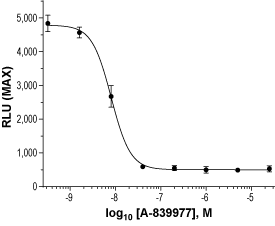Overview
- Honore, P. et al. (2009) Behav. Brain. Res. 204, 77.
 Alomone Labs A-839977 inhibits human P2X7 receptors expressed in HEK-293 cells.Dose-response curve of hP2X7 inhibition by A-839977 (#A-470). Cells were loaded with Fluo-8 NW dye, incubated with increasing concentrations of A-839977, and stimulated with 80 µM BzATP. Changes in intracellular Ca2+ following agonist application were detected as changes in maximum relative fluorescence (RLU) using FLIPRTETRA™. IC50 was calculated at 8 nM
Alomone Labs A-839977 inhibits human P2X7 receptors expressed in HEK-293 cells.Dose-response curve of hP2X7 inhibition by A-839977 (#A-470). Cells were loaded with Fluo-8 NW dye, incubated with increasing concentrations of A-839977, and stimulated with 80 µM BzATP. Changes in intracellular Ca2+ following agonist application were detected as changes in maximum relative fluorescence (RLU) using FLIPRTETRA™. IC50 was calculated at 8 nM
- Honore, P. et al. (2009) Behav. Brain. Res. 204, 77.
- Stokes, L. et al. (2006) Br. J. Pharmacol. 149, 880.
- Donnelly-Roberts, D.L. et al. (2009) Br. J. Pharmacol. 157, 1203.
A-839977 is a potent and selective antagonist of the P2X7 receptor. It inhibits BzATP-induced Ca2+ responses of human, rat and mouse P2X7 receptors with IC50 values of 20 nM, 42 nM and 150 nM, respectively1.
Selective P2X7 receptor antagonists, including A-839977, reduce inflammatory and neuropathic pain in animal models. In mice, A-839977 produces robust anti-hyperalgesia in a model of inflammatory pain.
The P2X7 receptor is a member of the ligand-gated ion channels activated by extracellular ATP. There are seven receptor subtypes: P2X1–P2X7. P2X7 receptors participate in a variety of cellular responses such as membrane permeabilization, activation of caspases, cytokine release, cell proliferation, and apoptosis. P2X7 receptors are highly expressed throughout autonomic, sensory and central neurons and in visceral smooth muscle, immune cells and epithelia2,3.
A-839977 (#A-470) is a highly pure, synthetic, and biologically active compound.

